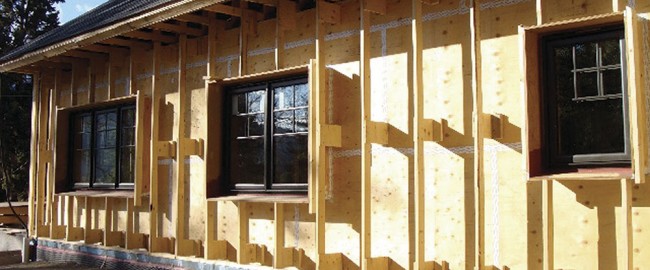
Photo Credit: Photo Ken Alton
Up to Code: Could new regulations lead to building revolution?
As I walk through the entrance to Vicki and Ken Alton’s new home it’s hard to tell it apart from any other. The uniqueness of this house does not just exist on the surface; it’s deep within the walls.
Gorgeous hardwoods stretch throughout the main floor and the small, European-style refrigerator catches my eye: stainless steel and about half the size of a conventional fridge. “We wanted to keep everything as efficient as possible,” Vicki tells me as she pulls out the energy consumption card confirming its efficiency.
She tours me around the still-under-construction house, highlighting several characteristics that will allow the Altons to drastically cut back on their energy needs. Plywood sealed with adhesive tape was used as vapour barrier, with a Larson truss system (known for providing more space for insulation) wrapped around the house to make the walls 20 inches thick. Cellulose insulation, made from recycled newspaper, was blown inside the wall cavities, making them incredibly dense and more than doubling the recommended requirement.
“We wanted to build something that was going to last 150-plus years and require very little upkeep,” Vicki says. “There are many factors to consider, from how a product is made, re-using or recycling, to using local expertise and material, to the energy-efficiency aspect.”
Code confusion
Until now, throwing up a conventional stick-frame house was relatively straightforward: foundation, exterior walls, roof, moisture-barrier, windows, doors, insulation, drywall and you’re halfway there. But BC’s new building codes, which came into effect in December, make it a bit more complicated.
The building envelope is where it all starts. It’s like a jar of pickled cucumbers: as long as it’s sealed properly, it’ll last forever. Because of BC’s climate diversity—dry, cold, hot and moist—with a temperature index that tips near -40 C in the far reaches of the North to 10 C in Victoria in January, the province been broken into six climate zones with the Bulkley Valley in Zone 7A, Prince Rupert in Zone 5 and Prince George in Zone 6.
In Smithers, for example, this means the average climate requires a tighter barrier against the elements: more insulation combined with increased airflow throughout the home, not to mention new ventilation standards for an abundant, odourless gas known as radon (see Silent but Deadly).
But not everyone is cheering the recent changes. In April, a group of local contractors gathered at Smithers’ town hall. They came to hear and learn about new building regulations that could potentially make their lives a bit more hectic. Although the update is well intentioned, some feel the new regulations border on excessive and, in some ways, are so convoluted even the local building inspector and contractors are having trouble making sense of them all.
“For me, the larger questions are regarding the ventilation requirements and the use of heat recovery ventilators,” Smithers building inspector Roye Lovgren says about the new code’s suggested HRV systems, which continually replace interior air and run consumers around $4,000.
“Incoming air needs to be tempered or heated with a dedicated ducting system. At -20°C, will that incoming air increase by 20 degrees Celsius? No, it certainly won’t. The code also calls for efficiency to heat that air and I’m not quite sure what that efficiency means. It could mean an additional duct heater may be required, which one could expect increased costs to bring in that extra heated air.”
The town hall workshop was supposed to answer some tough questions for builders headed into another construction season. However, rather than bringing clarity, most left with more questions than answers. To most contractors, the new codes seem like unwanted hassles.
“My initial thoughts are it’s going to be a better product,” says general contractor Jason Konst. However, he questions the incongruity of removing certain items from exterior walls in order to make more space for insulation. “For example, we’re no longer allowed to put an electrical panel or pipes in an exterior wall. A lot of new designs are open concept so you don’t have a lot of interior walls to put pipes in, but you can put as many windows in an exterior wall as you want, so where is the practicality? We’re talking about thousands of extra dollars here.”
A contractor’s job is about to get a lot more interesting and calculated. Building a standard two-by-six wall will no longer cut it in a climate Zone 7 dwelling. The new code looks at the wall’s R-value, or measure of insulation, as a whole, taking into account studs that transfer temperature more effectively than the wall’s insulated cavities—known as thermal bridging. The more studs, the greater the heat loss.
As a result, not enough insulation to meet regulation can be stuffed into the 16-inch-wide cavities of a standard wall and additional Styrofoam sheeting may be required. An overall value of R-17.5 (achieved with R-24 insulating batts) for exterior walls is now the minimum requirement. Concrete foundations must also have Styrofoam sheets on the exterior bottom and sides to ensure sufficient insulation. Instead of calculating the amount of insulation needed just for one wall cavity, you now need to calculate the R-value of the whole wall to meet regulations: no more thermal bridging and no more air pockets prone to mold and other climate-related damages.
To build a better house, more research needs to be conducted in the planning stages and innovative ideas need to be implemented, such as engineering walls that are either thicker or allow for wider insulation cavities than the standard 16-inch-on-centre. The changes mean a shift in construction practices and philosophy.
Downsize to up efficiency
As non-building folk, terms like R-values, thermal bridging and heat recovery ventilator mean very little. What does matter is the bottom line: what does this mean for the homeowner? Very simply, it means building your dream home is going to cost more.
Typically, a new house in Smithers is around $300,000. According to several local contractors, the average increase on a project under the new building codes will cost about 10 to 15 percent more, adding roughly $45,000 to the total cost—potentially a deal-breaker for many homebuilders: “They’re saying it’s going to save energy and I agree,” Smithers contractor Dwayne Van Veldhuizen says. “But the initial building cost is going to go up at least 10 percent.”
It begs the question that if people can’t afford to build a new house, will there be fewer people constructing them? Not necessarily.
A way to offset increased building costs could be downsizing: cutting down on square footage and increasing the functionality and livability of smaller spaces, as well as getting creative and finding solutions that not only make a house more efficient, but also sustain the high-quality lifestyles to which many North Americans have become accustomed.
According to a recent presentation by geoscientist David Hughes in Smithers, the average Canadian uses 19 times more energy per capita than the average citizen in India, one of the world’s fastest-growing economies. This should be an alarming reality check. We waste immense amounts of energy heating and cooling overly large, inefficient houses.
Although spending more money up front will save in the long run, it’s going to take a major buy-in from both industry and consumers to make it happen. With technologies such as solar cells, geothermal heating, LED lighting, better use of recycled materials and using 40-year-old technology like structurally insulated panels (SIPs), whose pre-fabricated plywood-and-polystyrene inserts go above and beyond new requirements, the tide is turning.
Perhaps the recent building code changes will inspire a new building standard that values efficiency and functionality over convenience and second-rate construction projects, creating more homes like the Altons’.
“We wanted to keep our footprint small,” Ken Alton says. “Despite the pressure to keep building three-bedroom houses for ‘resale,’ we wanted to invest up front in insulation rather than the long-term expense of heating costs.”





